|
Paper 61
Wilson and Williamson's Circular System of English Country Dancing, 1818
Contributed by Paul Cooper, Research Editor
[Published - 27th December 2022, Last Changed - 5th February 2023]
A rather curious dance publication was issued in London in 1818 that introduced A New Circular System of English Country Dancing (see Figure 1). The authors of this brief work were Thomas Wilson and Richard Williamson. Their exotic new technique for country dancing did not change the world, it may barely have been danced at all, it was novel however and could be fun to dance today. In this paper we'll describe their technique, provide a transcript of their publication, and discuss the broader social dancing context in which their publication appeared. As far as I'm aware this book has never before been published on the internet, the transcript should therefore be of some interest to dance historians and enthusiasts.
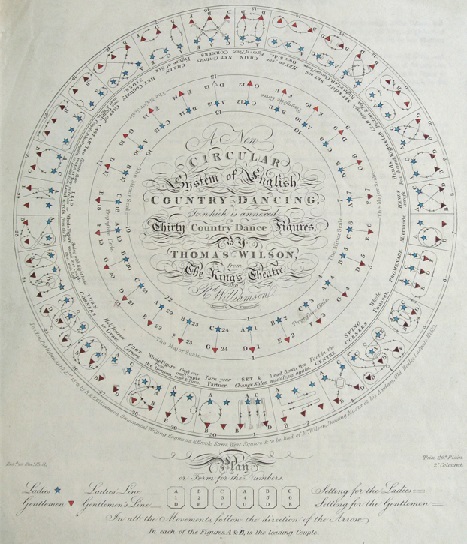
Figure 1. A New Circular System of English Country Dancing by Thomas Wilson and Richard Williamson, 1818, side 1. Image courtesy of the Royal Society of the Arts.
Thomas Wilson & Richard Williamson
The authors of our mysterious work were Thomas Wilson and Richard Williamson. Wilson (1774-1854) hardly requires an introduction, he was the most prolific writer on social dance topics of his generation. We've previously shared a biography of Wilson and a bibliography of his many works, you might like to follow the links to read more. Wilson, at the 1818 date of publication, was a successful writer, dance tutor, and host of public balls. Many of his great works were already published (some in several editions), he operated at least four dance academies at different addresses in London, he would host his 76th public ball in March of 1818. And he was not yet finished; he had several further projects in-hand, including the ongoing work on The Complete System of English Country Dancing (an early reference to which exists within our publication); another major work that may have been brewing would eventually be named The Quadrille and Cotillion Panorama, the first volume of which was issued in 1819. He found time to work on several minor works between his larger projects, including our Circular system of country dancing.
Wilson's collaborator on this project was Richard Williamson, a man of whom much less is known. It's unusual for Wilson to have acknowledged a collaboration with anyone at all, this is the only Wilsonian publication I know of for which a co-author is named (as compared to a publisher, composer, or similar). We might wonder what the two collaborators individually brought to the project. Williamson was, primarily, an engraver. As an engraver he would have been responsible for creating imagery etched into plates (perhaps made of copper, pewter or even steel), these plates in turn would be used in the publishing process. Engraving was an important skill, music shops (for example) would have employed engravers to produce plates of their musical notation ready for printing. Wilson employed engravers to create his many dance illustrations. R & E Williamson would go on to engrave and publish Wilson's Quadrille and Cotillion Panorama publication from 1819.
Williamson was evidently a master of his trade. When the 1818 Royal Commission on the Means of Preventing Forgery sought suggestions for preventing the Forgery of Bank Notes , Williamson provided one of the 108 submissions that they received. Williamson's proposal involved a machine that would etch complex intaglio designs on to steel plates, that design could then be incorporated into the bank notes. He'd already worked with several provincial banks before submitting his ideas to the commission. Sadly his design was not one of the nine that were shortlisted for further consideration, they evidently however selected a similar proposal from someone else. This in turn resulted in Williamson petitioning parliament in 1820 complaining that an invention of his, for preventing the forging of notes, had been adopted by the Bank without acknowledging it; that the Bill before the House for the protection of the new notes would exclude him from supplying the country banks he had hitherto done. He therefore prayed that the Bill might not pass into a law without some enactments being provided for his protection. (The Globe, 11th July 1820). A description of Williamson's steel plates can be found in the Transactions of the Royal Society of Arts for 1819.
The firm of R. & E. Williamson operated at 8 Brook Street, West Square, London at our 1818 date, sometime thereafter they moved to 14 Moore Place, New Bethlem, London, an address they retained until at least 1847. Some references suggest that they may have specialised in engraving calligraphic writing (they even described themselves as Ornamental Writing Engravers within our publication). Unfortunately I've discovered little else of Williamson's life and works, if you know more then do please let us know.
Evaluation of the Author's Contributions
The publication itself consists of a single sheet of paper with information on both sides. The first side consists of an ornately engraved image of a longways dance bent around into a circle (we'll discuss how that would work shortly), see Figure 1. Around the outside of that diagram are thirty smaller images depicting a variety of Country Dancing figures. The other side (see Figure 4) contains a textual description of the new circular system of country dancing, together with a brief textual description of each of the thirty figures depicted on the first side. The original publication was sold at a price of 1s 6d uncoloured or 2s coloured. The bulk of the information in this brief publication pertains to regular country dancing figures of the type that Wilson had previously described in his An Analysis of Country Dancing publication, the new information pertaining to the circular system fills perhaps a third of the total space.
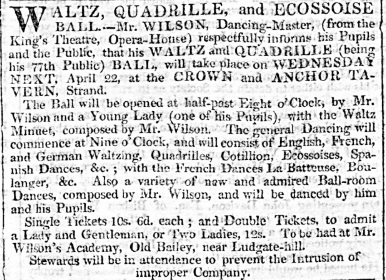
Figure 2. Advertisement for Thomas Wilson's 1818 77th public ball (at which the Circular System was said to have been first danced), from the New Times, 20th April 1818. Image courtesy of the British Newspaper Archive.
The publication became available to the public in 1818. It was issued without fanfare (I've not discovered any published advertisements for it) but it was reviewed, albeit minimally, in La Belle Assemblée magazine number 110 for May 1818. They wrote that it presented a novel and agreeable system to the votaries of Terpsichore, which enables a whole company to commence a dance at the same time. The reference to Terpsichore is to the Muse of Dance in Greek mythology. It's not clear to me that the reviewers had any particular insight to offer, or even that they had studied the publication in any detail at all. One of the more exotic features of the circular system of dancing was that everyone could commence dancing at the same time, we'll return to consider that further below; the significance of this innovation seems to have escaped their attention, the bulk of their review simply quotes from the publication itself.
The question remains however as to what the two contributors offered to the work. Wilson, very clearly, provided the descriptions of the figures. We've discussed Wilson's distinctive style of Country Dancing before, this work is entirely consistent with his way of doing things. He must have provided the text describing the various figures employed in country dancing. Whereas Williamson was responsible for the final form of the diagrams, no doubt in close collaboration with Wilson. But who invented the novel aspects of the dance format? Both of our authors individually claimed credit for it. Wilson, in the back of his 1821 publication The Address, listed several modern dance forms invented and composed by Mr Wilson, and correctly taught by him , amongst them was The New Circular System of English Country Dancing, first introduced at his Waltz and Quadrille (being his 77th public) Ball, at the Crown and Anchor . Wilson's 77th public ball was (according to an advertisement in The New Times newspaper for the 20th of April 1818, see Figure 2) held on the 22nd of April 1818 at the Crown & Anchor Tavern, it was promised that: The general dancing will commence at Nine o'clock, and will consist of English, French, and German Waltzing, Quadrilles, Cotillion, Ecossoises, Spanish Dances, &c; with the French Dances La Batteuse, Boulanger, &c. Also a variety of new and admired Ball-room Dances, composed by Mr Wilson, and will be danced by him and his Pupils . The circular system, if it was danced at that 1818 event at all, wasn't advertised in advance. It may very well have been performed there, perhaps by Wilson's pupils, perhaps under that assumed title of a new and admired Ball-room dance . It may be significant that the Boulanger dance was mentioned as this was a popular circle dance, it might have been easier to demonstrate the new circular system of country dancing after the Boulanger had already been danced. The circular system doesn't seem to have been particularly popular though; not only did Wilson himself fail to name it in the advertising for this ball, he failed to do so (as far as I can determine) for any subsequent balls that he hosted either. Williamson, on the other hand, also claimed credit as the inventor. He submitted two copies of the publication to the Royal Society of the Arts, a copy of his accompanying letter still survives today in the archives of the RSA; it reads: To the society of Arts Manufacturers & Commerce, Gentlemen, I have enclosed you 2 copies of a New Circular System of English Country Dancing invented and arranged by me, Richard Williamson, which I beg leave to submit to your inspection and hope at least they will find a place in your ?shelves? [word uncertain] which will much oblige. Gentlemen, your obedient servant, Richard Williamson . The letter was dated April 22nd 1818 (which is the same day that Wilson is understood to have debuted the dance at his 77th public ball). Thus both contributors claimed credit for the invention of the system.
It is possible that Williamson only intended to claim credit for inventing the visual design of the work, which was indeed novel, and that Wilson invented the idea. It's also possible that Williamson invented the entire concept, perhaps persuading Wilson to publicise it in return for his ongoing support for Wilson's other projects (notably the Quadrille & Cotillion Panorama). And it's possible that both collaborators jointly contributed to all aspects of the work. It seems likely that Williamson would have studied dance at Wilson's academies, he was presumably one of Wilson's many pupils, perhaps they discovered a mutual interest together. Williamson's contributions were surely more than that of a simple engraver, Wilson never credited his engravers as co-authors in any previous or succeeding work. Indeed, a close reading of the opening line of the descriptive text reveals that The Author has been induced to present this Plan to the Public , this text may hint that while Wilson considered himself to be the author of the work he did not consider himself to be the inventor , he was simply induced to present somebody else's ideas. I therefore suspect (but cannot proove) that Williamson really did offer the initial idea for this system up to Wilson, the two of them then worked on the publication together. One can almost imagine Williamson's excitement on the 22nd: an initial batch of his vanity publication had been printed and coloured, copies had been posted to the Royal Society of the Arts, he would be attending a ball hosted by his friend Thomas Wilson that evening at which the dance would be publicly shown, quite possibly with himself taking a leading role within the performance. Then, quite sadly and in all probability, that was the end of it... a few copies of the work would have been sold but the initial print run probably satisfied demand, the dance was probably not heard of again until the modern era.
Novel Aspects of the Circular System of Country Dancing
Let's turn our attention to the dance form itself now. A transcript of the work is provided further below but it's difficult to read and understand. We'll first review the main characteristics of the dance form. But before we start it might be worth reviewing the conventions for regular country dancing in the early 19th century, we've written on this subject before so you might like to follow the link to read more.

Figure 3. The progressive circle of the circular system of country dancing. Image courtesy of the Royal Society of the Arts.
The most obvious innovation of the circular system of country dancing is that a longways set of couples is bent around into a circle (see Figure 3). The man from each couple is placed on the outside of the circle and the lady on the inside. The diagram from the publication envisages having 24 couples around the circle, though any number could be made to work. The man from each couple is depicted in the diagram with a red triangle symbol, the lady with a blue star, the couples will be found to number from 1 to 24 (the 1 couple being at the bottom of the image). This new geometric arrangement would be a novelty in the ball room and immediately makes for something a little different for the dancers to enjoy. It isn't the primary innovation however.
The next point to note is that the minor sets around the circle have to be identified before the dancing can begin. In the modern world we usually accomplish this by announcing hands four or hands six as the dancers line up so that groups of either four or six dancers take hands along the length of the line; this concept is so ubiquitous today that many dancers might assume that this was normal in the early 19th century too. It wasn't (at least not in the contexts for which we have documentary evidence). In the circular system these minor sets of four or six dancers must be identified before dancing can commence. Furthermore, a neutral couple must be allocated between each such minor set. A neutral couple is an inactive pair of dancers who are temporarily out of the dancing (they will be drawn into the dancing on the second iteration of the dance). One couple is arbitrarily declared to be the top-most couple of the circle (that's couple 1 in the diagram) and everyone else has their positions set relative to that top most couple. When allocating positions we have to take the neutral couple for each minor set into consideration. We now have two options to consider:
- If the dance is going to require two active couples for the figures (i.e. it's what's often referred to as a
duple-minor dance) then the third couple will be neutral. So the 24 couples in the diagram arrange themselves into eight groups of three couples. The diagram from the publication depicts this with numbers on the inner edge of the circle of dancers (named The Minor Scale in the diagram); a new minor set begins at couples 1, 4, 7, 10, 13, 16, 19 and 22. There are two couples in each of the eight minor sets and a neutral couple separating them from the next minor set. The neutral couples are in positions 3, 6, 9, 12, 15, 18, 21 and 24.
-
If the dance is going to require three active couples for the figures (i.e. it's what's often referred to as a
triple-minor dance) then the fourth couple will be neutral. So the 24 couples in the diagram arrange themselves into six groups of four couples. The diagram from the publication depicts this with numbers on the outer edge of the circle of dancers (named The Major Scale in the diagram); a new minor set begins at couples 1, 5, 9, 13, 17, and 21. There are three couples in each of the six minor sets and a neutral couple separating them from the next minor set. The neutral couples are in positions 4, 8, 12, 16, 20 and 24.
When the dance begins the first couple in each minor set leads off the dancing with the couple (duple-minor) or two couples (triple-minor) immediately below them around the circle. Thus everybody, with the exception of the neutral couples, begins dancing at the same time. This is in stark contrast to the regular conventions at the time; in a normal country dance most of the dancers down a longways set would be stood neutral and must wait for the first couple to reach them before they were absorbed into the dancing. Removing all of that waiting time would make for a more immediate dancing experience. The diagram assumes 24 couples will be dancing, if there are some other number then the dancers must still group themselves into collections of either 3 or 4 couples, additional neutral couples can be placed (if necessary) between the bottom of the final minor set and the start of the first minor set.
The next novelty to consider is the progressive nature of this dance form. The first couple in each minor set remains a first couple until they have progressed all the way around the circle back to where they had started, which is likely to be 24 iterations of the music (an iteration per couple who are dancing). That in itself isn't especially novel. And when the dance finally ends, the whole experience should start again with the second couple from each minor set taking a turn to lead off; and so on until everybody has had their chance to lead the dancing (which is three times through for a duple-minor, or four times through for a triple-minor). Again, none of this is especially novel. What is a little odd is the experience for everyone who isn't leading off their minor sets. The country dance works in an approximately normal way regarding progression: on the second iteration of the music the leading couple dances with the couple(s) that are now below them (they were originally either the neutral couple of the duple-minor, or the third couple and neutral couple of the triple minor), the former second couple now having progressed to become a neutral couple for a turn. And thus the dance continues; for a duple minor the second and neutral couple alternate with each iteration of the music, for a triple minor the second, third and neutral couples strobe their way through the positions with each iteration of the music. This too is normal, though most country dancers today omit the use of a neutral couple between minor sets. This isn't the most interesting aspect of the dance however, it merely sets the scene for explaining the great innovation.
The aspect of this circular dance form that I find most interesting isn't explicitly mentioned in the publication at all. I suspect it's something that would have been so obvious when the work was first published that it didn't even need to be mentioned, yet it's something almost completely alien to the modern experience of country dancing. The question might be asked: "How did the dancers know what figures to dance?". We might speculate that a Master of the Ceremonies decided what was to be danced and explained those figures to the assembled company before dancing commenced, that's certainly possible; or perhaps the first couple of the first minor-set selected the figures and once again the M.C. propagated them around the room. Either scenario is possible but I don't think that's what was intended. My theory (and it's just a theory, you might decide otherwise for yourself once you've read the transcript) is a little strange. You might be aware that the convention in the Assembly Rooms of Regency Britain was that the topmost couple of a longways set, typically the lady, would select the figures to be danced in-situ just before the dancing would begin (if not, you can read more here). My reading of the circular system is that the first couples of each minor set, independently of all the others, could similarly select any figures that they liked for their minor set to dance. Around the circle of 24 couples there would be either eight (duple-minor) or six (triple-minor) minor sets dancing their own distinctive sets of country dancing figures simultaneously. Thus six or eight different country dances were being danced concurrently around the same circle. This in turn explains why it would be so important for a neutral couple to be placed between each minor set; as each couple progresses above their leading couple they get one turn of the music to pause as a neutral couple, they have to shift their attention away from the minor set they were dancing with and start paying close attention to the new minor set that is progressing towards them; they must memorise the new set of figures to dance while they're stood neutral, then dance them themselves on the following iteration of the music with a new leading couple!
If I've understood the system correctly, the supporting couples in each minor set have a significantly more interesting dancing experience than would normally be the case in country dancing; they not only have to contend with toggling between second, third and neutral couples within a set, they must also toggle from one set of figures to the next during their turn as a neutral couple. This dance form will require significant attention from the inactive dancers! And yet it's not overly difficult to dance, it follows the basic conventions of country dancing that would have been understood at the time... I think it could be quite an interesting novelty and something that modern country dancers might very well enjoy experimenting with.
Transcript of the Work
What follows is the descriptive text written by Wilson and Williamson to describe their New Circular System of English Country Dancing (see Figure 4). The text refers back to the main diagram (see Figure 3).
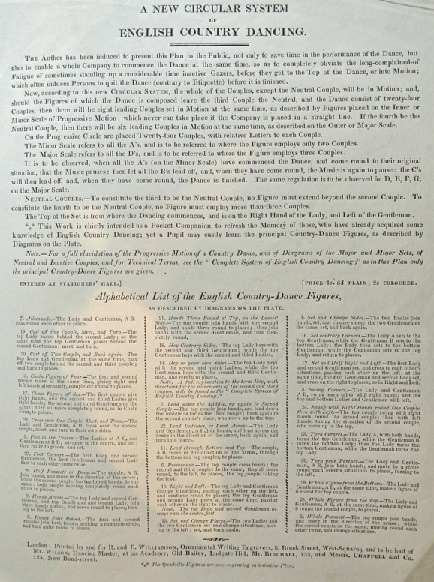
Figure 4. Recto of the New Circular System of English Country Dancing. Image courtesy of the Royal Society of the Arts.
The Author has been induced to present this Plan to the Public, not only to save time in the performance of the Dance, but also to enable a whole Company to commence the Dance at the same time, so as to completely obviate the long-complained-of Fatigue of sometimes standing up a considerable time inactive Gazers, before they get to the Top of the Dance, or into Motion; which often induces Persons to quit the Dance (contrary to Etiquette) before it is finished.
Now, according to this new Circular System, the whole of the Couples, except the Neutral Couple, will be in Motion; and, should the Figures of which the Dance is composed leave the third Couple the Neutral, and the Dance consist of twenty-four Couples, then there will be eight leading Couples in Motion at the same time, as described by Figures placed on the Inner or Minor Scale of Progressive Motion; which never can take place if the Company is placed in a straight line. If the fourth, be the Neutral Couple, then there will be six leading Couples in Motion at the same time, as described on the Outer or Major Scale.
On the Progressive Circle are placed Twenty-four Couples, with relative Letters to each Couple.
The Minor Scale refers to all the A's, and is to be referred to where the Figure employs only two Couples.
The Major Scale refers to all the D's, and is to be referred to where the Figure employs three Couples.
It is to be observed, when all the A's (on the Minor Scale) have commenced the Dance, and come round to their original situation, that the Music pauses: then let all the B's lead off, and, when they have come round, the Music again to pause: the C's will then lead off, and, when they have come round, the Dance is finished. The same regulation is to observed for D, E, F, G on the Major Scale.
NEUTRAL COUPLES - To constitute the third to be the Neutral Couple, no Figure must extend beyond the second Couple. To constitute the fourth to be the Neutral Couple, no Figure must employ more than three Couples.
The Top of the Set is from where the Dancing commences, and is on the Right Hand of the Lady, and Left of the Gentleman.
* This Work is chiefly intended as a Pocket Companion, to refresh the Memory of those, who have already acquired some knowledge of English Country Dancing; yet a Pupil may easily learn the principal Country-Dance Figures, as described by Diagrams on the Plate.
Note - For a full elucidation of the Progressive Motion of a Country Dance, and of Diagrams of the Major and Minor Sets, of Neutral and Inactive Couples, and for Technical Terms, see the Complete System of English Country Dancing ; as in this Plan only the principal Country-Dance Figures are given.
The remainder of the publication consists of a brief description of thirty country dancing figures accompanied by a small image depicting the figure. These details can be quite interesting but they're not unique the circular system of country dancing, we'll therefore offer that information at the end of this paper by way of an appendix.
Significance of the Circular System
The circular system of country dancing seems not to have been widely danced in London when it was first issued in 1818. Thomas Wilson might indeed have featured it in his 77th public ball that year, perhaps he did so again afterwards (I have no information to suggest either that he did or that he did not). When viewed in isolation this dance form was an exotic novelty that had no great significance to the broader history of country dancing. And yet it is representative of a wider trend in social dancing of the later 1810s and may have influenced some of the exotic dance forms of the early 1820s.
One of the trends that appears in country dancing in the 1810s is an interest, at least amongst those dancing masters who advertised to the public, in novelty. An abundance of off-formula novelty dances were taught, and in some cases were publicly danced, across the 1810s. Some of the newer dances went on to great success, the Waltz couple dance and the Quadrille being prime examples; others were briefly popular such as the Spanish Country Dance, others still seem barely to have been danced at all when first introduced. Thomas Wilson in the 1811 editions of his Analysis of Country Dancing introduced a new repertoire of exotic country dancing figures such as the Double Ovals, Snake, True Lover's Know and so forth; there's little evidence that they were danced outside of his academy, they are however evidence that some dancers wanted more from their country dancing. Edward Payne introduced his Spanish Country Dances from around the year 1814, they in turn may have influenced Wilson's Waltz Country Dances that flourished from 1815. Wilson's Ecossoises were introduced in 1817 and G.M.S. Chivers taught his Swedish Country Dances in 1818. Each of these systems offered variations on the standard formula of the country dance. None of them shared the innovations of the Circular system of country dancing, that seems to have been new in 1818.
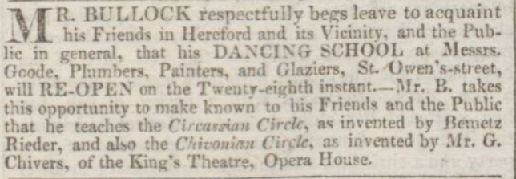
Figure 5. Advertisement by Mr Bullock offering tutition in two types of circular dances, Hereford Journal, 21st of July 1824. Image courtesy of the British Newspaper Archive.
Interest in circular dance forms did increase in the early 1820s. A dancing master named Mr Bemetzrieder claimed credit for inventing the Circassian Circle (also known as the Sicilian Circle) somewhere around the year 1820 (see for example Figure 5 in which the dance is credited to him); this dance form involved couples facing each other around a circle, they would dance quadrille like figures in their groups of four with a country dancing progression in each iteration of the dance. This system of dancing is very similar to that of our Circular system, it might have been influenced by Wilson and Williamson's invention. Shortly thereafter G.M.S. Chivers introduced the Chivonian Circle, certainly no later than 1822; it was very similar to the Circassian Circle except that lines of four would face each other around a circle (perhaps like spokes of a wheel) rather than pairs of dancers doing so. Wilson taught his Circular Quadrilles in 1822 (The Statesman, 6th of March 1822), they may have been similar to the Circassian Circle. Both the Circassian (or Sicilian) and Chivonian circles were somewhat popular in 1824, a wide array of provincial dancing masters advertised tuition in the dances that year, including Mr Bullock of Hereford, see Figure 5. By 1825 Chivers taught a dance that he named The Circular Saraband. All of these new dance forms may have owed something to Wilson and Williamson's Circular System of Country Dancing. And they all in turn may have owed something to an older circular dance named The Boulanger, this was a French Country Dance that probably dated back to the 1760s, it was known in London from at least 1780; in this dance as many couples as wish would form a circle, with everybody standing side by side around the circle facing inwards.
It's entirely possible that other circular dances existed before or after the date of Wilson and Williamson's system, or that other aspects of their system had been independently invented elsewhere. For example, a dancing master named Mr West of Derby (Derby Mercury, 27th June 1805) claimed to have invented an improved method of dancing Country Dances, wherein the inconvenience of waiting for the first couple's coming down is obviated, and the whole company are in motion at once . It's entirely possible that West had invented essentially the same dance as our Circular country dances at an earlier date. His innovation could have been something completely different of course, we don't know what he had created for his pupil's enjoyment. In all probability somebody, somewhere, had experimented with circular country dances before Wilson got there. And yet the date of Wilson's publication seems significant, he offered it to the public just before circular dancing saw an increase in interest, that might not be a coincidence.
Conclusion
Wilson and Williamson's New Circular System of Country Dancing is a fascinating, if brief, publication which offers an insight into one of the more novel dance innovations of the 1810s. There's little evidence of it having being danced socially, the book seems more of a vanity publication issued at the whim of the authors and of no lasting consquence. It could have inspired some of the innovative circular dances of the early 1820s, dances that in some cases have lived on into the modern era.
It might however be a fun system to recreate today. The idea of six different country dances, all being enjoyed simultaneously, to the same tune and around the same circle, could be quite a party game. If you decide to recreate the dance, please consider recording a video of the experience and sharing it!
We'll leave the investigation into this unique dance publication here. If you have any further information to share on this subject, or anything else you think might be of interest, then do please Contact Us as we'd love to learn more.
Appendix - Alphabetic List of the English Country-Dance Figures
We'll end this paper with a transcript of the remainder of the original work. It consists of a brief textual description of thirty of the more popular country dancing figures with a brief illustration of each one. These figures are in no way unique to the Circular system of country dancing, in most cases they're a subset of the information from Wilsons's 1808 An Analysis of Country Dancing. They were presented with the new images of the figures engraved by Williamson, these images are crisper and less cluttered with superfluous detail than are the equivalent images in Analysis.
For a more complete description of these figures you might find our index of Wilsonian descriptions of country dancing figures useful.
| Figure | Image | Description |
|---|
| Allemande | 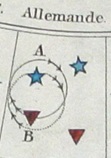 | The Lady and Gentleman, A B, pass round each other to places. |
| Cast off One Couple, Meet, and Turn | 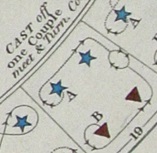 | The top Lady passes behind the second Lady; at the same time, the top Gentleman passes behind the second Gentleman; meet, and turn. |
| Cast off Two Couple, and Back again |  | The top Lady and Gentleman, at the same time, cast off two couple behind the second and third couple; and back to places. |
| Chain Figure of Four | 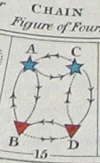 | The first and second couple move at the same time, giving right and left hands alternately, completely round to places. |
| Chain Figure of Six | 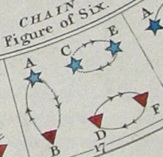 | The first couple give right hands, and the second and third Ladies give right hands; the second and third Gentlemen do the same; they all move completely round, as in Chain Four, to places. |
| Cross over One Couple, Meet, and Turn | 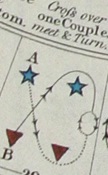 | The Lady and Gentleman, A B, cross over the second couple, meet, and turn to their own sides. |
| Foot in the Centre | 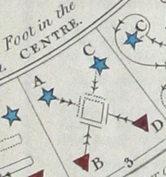 | The Ladies at A C, and Gentlemen at B D, advance to the centre, and set; then retire to places, and set. |
| Foot Corners | 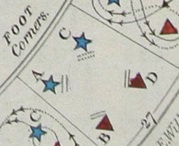 | The first Lady and second Gentleman, the first Gentleman and second Lady foot to each other cornerwise. |
| Half Poussett or Draw | 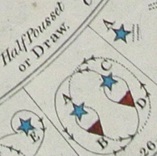 | The couple, A B, join hands, and move in the direction of the arrow; while the second couple, having joined hands, do the same: both couple moving completely round each other to places. |
| Hands Across |  | The top Lady and second Gentleman, and top Gentleman and second Lady, join right hands across, and move round to places, turning to the left. |
| Hands Four Round | 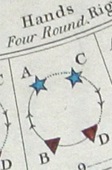 | The first and second couples join both hands, making a complete circle, and turn quite round to places. |
| Hands Three Round at Top, on the Ladies' Side | 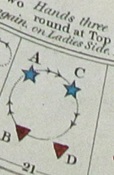 | The top couple join hands with the second Lady, and hands three round to places; then join hands with the second Gentleman, and turn completely round. |
| Hey Contrary Sides | 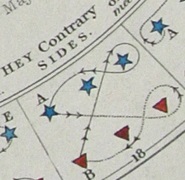 | The top Lady heys with the second and third Gentlemen; while the top Gentleman heys with the second and third Ladies. |
| Hey on your own Sides | 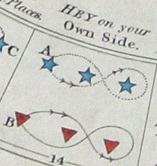 | The top Lady heys with the second and third Ladies; while the top Gentleman heys with the second and third Gentlemen, and return to places. Note. A full explanation to the term Hey, with directions for the movements of the second and third couples, will be found in the Complete System of English Country Dancing . |
| Lead down the Middle, up again to Second Couple | 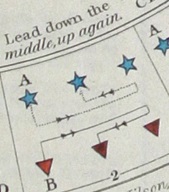 | The top couple join hands, and lead down the middle as far as the third couple; back again to the second couple's place, who move up to the top. |
| Lead Outsides, or Lead Across |  | The Lady and Gentleman, A B, join hands, and lead across the dance in the direction of the arrow, back again, and turn into places. |
| Lead through Bottom and Top | 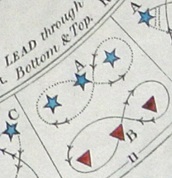 | The couple, A B, move in the direction of the arrow, through the bottom and top couples, to places. |
| Promenade | 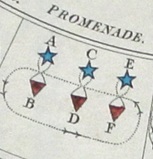 | The top couple cross hands; the second and third couples do the same; they all move round, to the left, to places, the top couple taking the lead. |
| Right and Left | 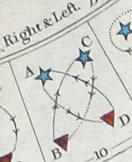 | The top Lady and Gentleman change situations, passing each other on the left, and continue round to places; the top Gentleman and second Lady move at the same time, passing each other on the right to places. Note. The top Lady and second Gentleman always pass the centre first. |
| Set and Change Places | 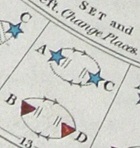 | The two Ladies and the two Gentlemen set and change situations, moving to the left; set, and back again. |
| Set and Change Sides | 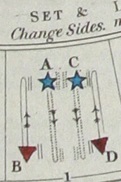 | The two Ladies join hands, set, and change sides; the two Gentlemen do the same, set, and back again. |
| Set contrary Corners | 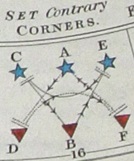 | The Lady A sets to the top Gentleman, while the Gentleman B sets to the bottom Lady; the Lady then sets to the bottom Gentleman, while the Gentleman sets to the top Lady, and return to places. |
| Set and Half Right and Left | 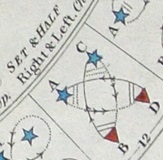 | The first Lady and second Gentleman set, and cross to each other's situations, passing each other on the left; at the same time, the first Gentleman and second Lady set, and cross on the right to places; as in Right and Left. |
| Swing Corners | 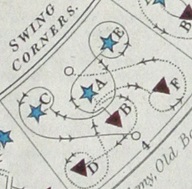 | The Lady and Gentleman, A B, swing each other with right hands; and the top and bottom Ladies and Gentlemen with left. |
| Swing with Right Hands round one Couple, then with Left | 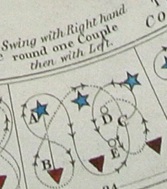 | The top couple swing with right hands round the second couple; then with left hands, taking the situation of the second couple, who move up to the top. |
| Turn Corners | 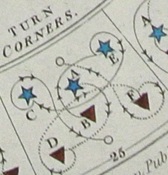 | The Lady A, with both hands, turns the top Gentleman; while the Gentleman B turns the bottom Lady; then the Lady turns the bottom Gentleman, while the Gentleman turns the top Lady. |
| Turn your Partner | 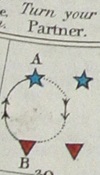 | The Lady and Gentleman, A B, join both hands, and move in a circle round each other's situations to places, turning to the left. |
| Whole Figure from the Bottom | 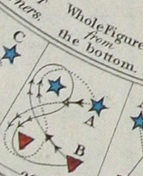 | The Lady and Gentleman, A B, at the same time, make a figure of 8 round the top couple. |
| Whole Figure from the top | 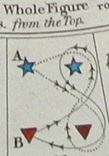 | The Lady and Gentleman, A B, at the same time, make a figure of 8 round the second couple, to places. |
| Whole Poussett | 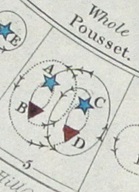 | The top couple join hands, and move in the direction of the arrow; while the second couple do the same, moving round each other twice, and change situations. |
|


 Figure 1. A New Circular System of English Country Dancing by Thomas Wilson and Richard Williamson, 1818, side 1. Image courtesy of the Royal Society of the Arts.
Figure 1. A New Circular System of English Country Dancing by Thomas Wilson and Richard Williamson, 1818, side 1. Image courtesy of the Royal Society of the Arts.
 Figure 2. Advertisement for Thomas Wilson's 1818 77th public ball (at which the Circular System was said to have been first danced), from the New Times, 20th April 1818. Image courtesy of the British Newspaper Archive.
Figure 2. Advertisement for Thomas Wilson's 1818 77th public ball (at which the Circular System was said to have been first danced), from the New Times, 20th April 1818. Image courtesy of the British Newspaper Archive.
 Figure 3. The
Figure 3. The  Figure 4. Recto of the New Circular System of English Country Dancing. Image courtesy of the Royal Society of the Arts.
Figure 4. Recto of the New Circular System of English Country Dancing. Image courtesy of the Royal Society of the Arts.
 Figure 5. Advertisement by Mr Bullock offering tutition in two types of circular dances, Hereford Journal, 21st of July 1824. Image courtesy of the British Newspaper Archive.
Figure 5. Advertisement by Mr Bullock offering tutition in two types of circular dances, Hereford Journal, 21st of July 1824. Image courtesy of the British Newspaper Archive.